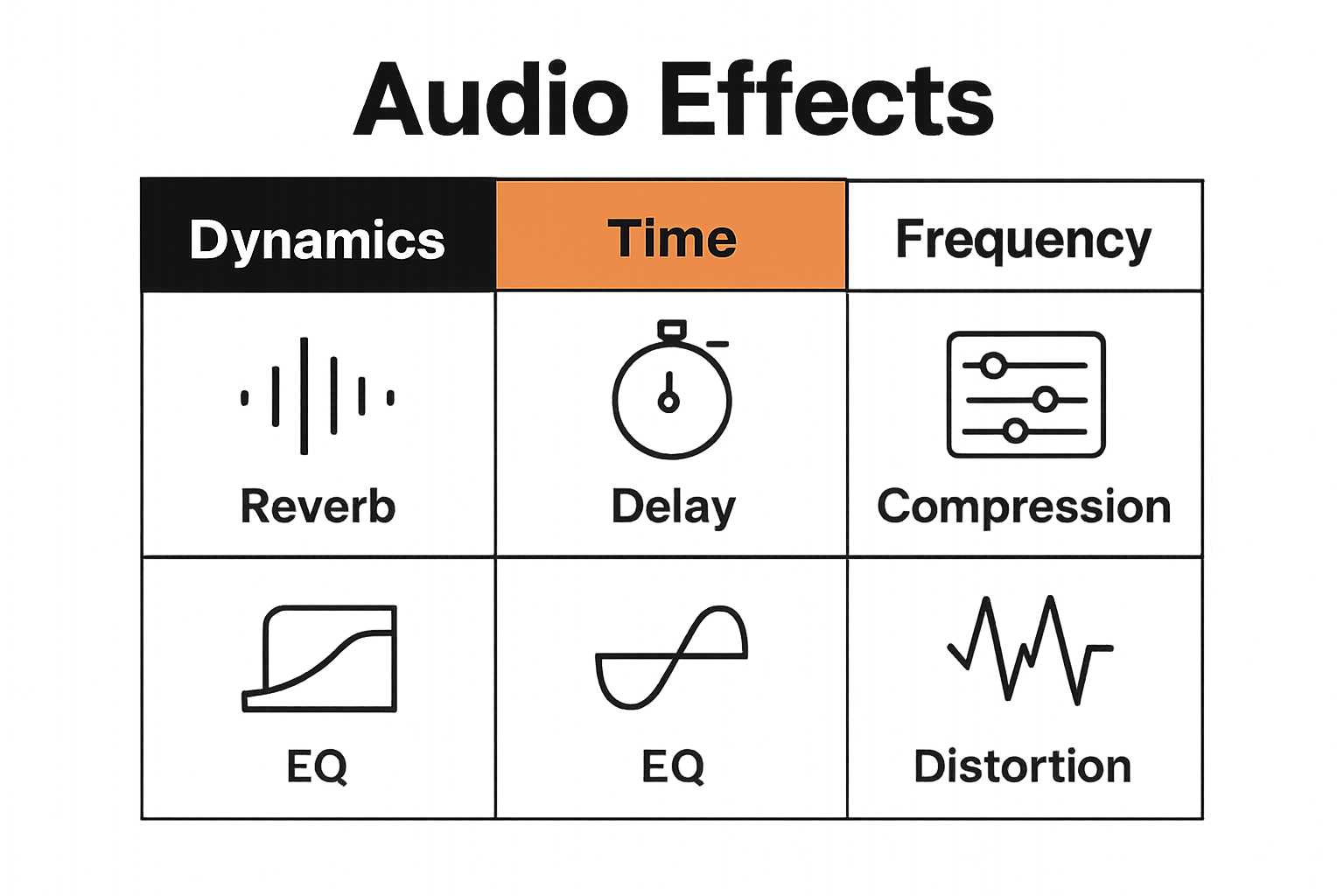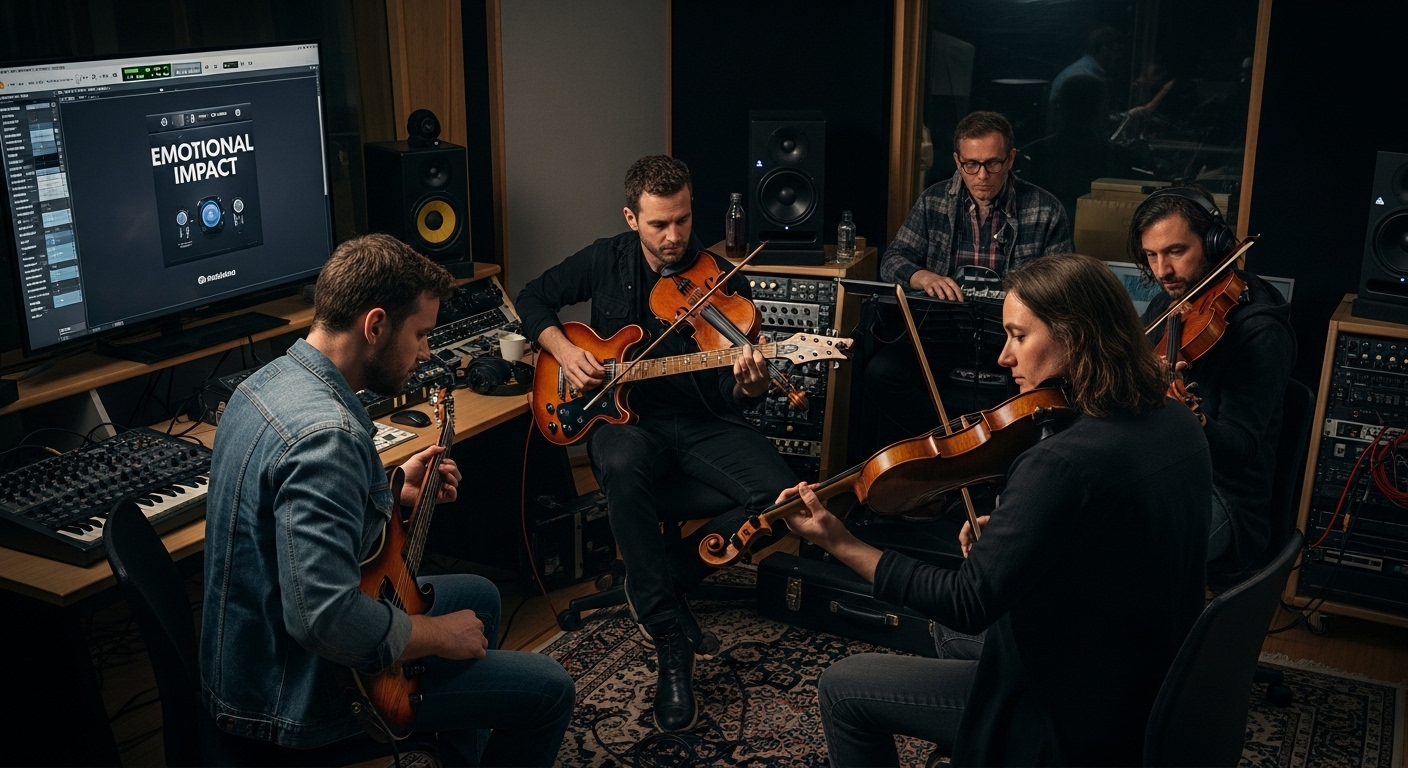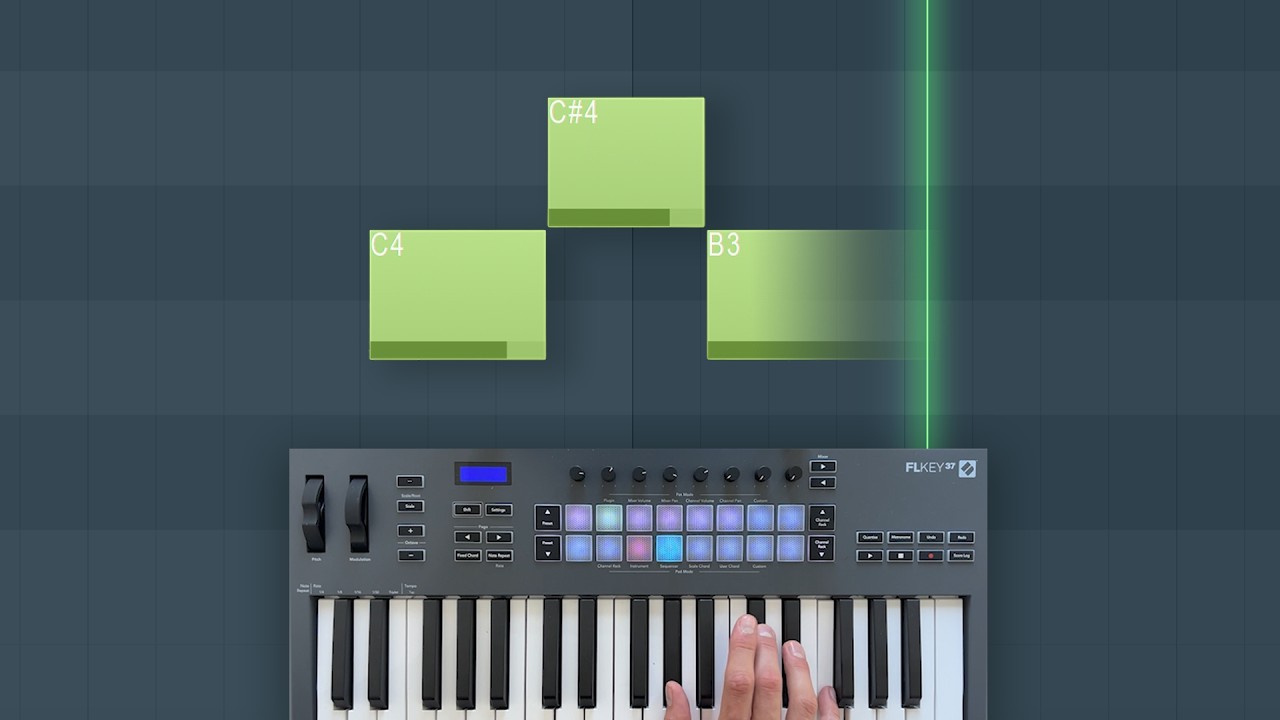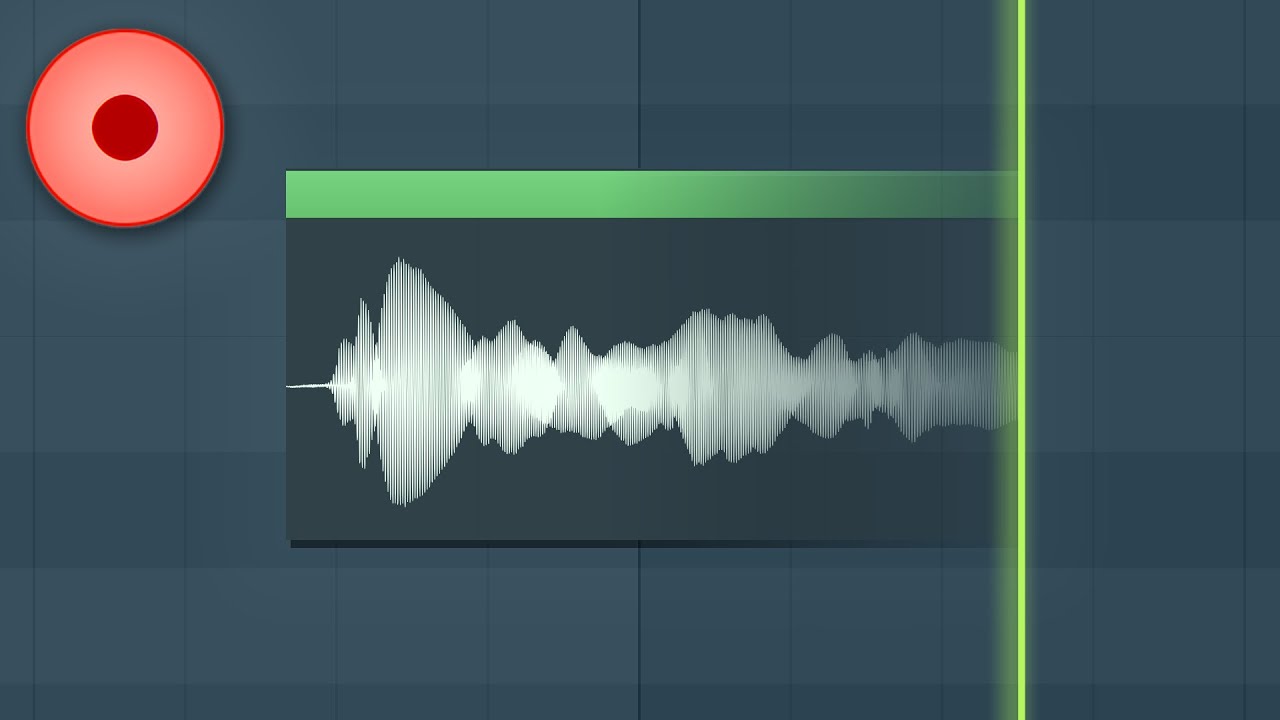!Let Us HELP YOU!
We have a lot of curated content on this blog.
Take this simple 20 second Quiz to Help You
Find The Exact Content You Are Looking For!
Audio effects can completely reshape a song. They let producers shift raw sound into something engineered with emotion and style. Yet while most think of these tools as lifeless gear, it turns out they have a far bigger role. Research shows that high quality audio processing can increase emotional engagement and trigger stronger listener reactions. Audio effects are not just technical fixes. They are the secret storytellers shaping how we feel every time we hit play.
Table of Contents
- What Are Audio Effects And Their Purpose?
- Why Audio Effects Matter In Music Production
- How Audio Effects Work: Key Concepts Explained
- Types Of Audio Effects And Their Applications
- Real-World Impact Of Audio Effects On Music
Quick Summary
| Takeaway | Explanation |
|---|---|
| Audio effects enhance emotional impact. | They amplify emotional intensity in music, creating deeper connections with listeners. |
| Audio effects correct technical imperfections. | They address issues like frequency balance and dynamic range, resulting in a polished sound. |
| Digital signal processing transforms sound. | DSP allows precise manipulation of sound characteristics, shaping audio in innovative ways. |
| Different categories serve unique purposes. | Effects like reverb, delay, and compression each fulfill distinct roles in sound design. |
| Audio effects create immersive sonic experiences. | By blending effects, producers cultivate rich soundscapes that engage and captivate audiences. |
What Are Audio Effects and Their Purpose?
Audio effects are specialized digital or analog processing techniques that transform and enhance sound recordings, enabling music producers to sculpt and manipulate audio signals in creative ways. These transformative tools represent more than just technical modifications – they are the sonic paintbrushes that allow musicians to craft unique sonic landscapes and emotional experiences within their music.
The Fundamental Purpose of Audio Effects
At their core, audio effects serve multiple critical functions in music production. They help producers refine sound quality, create depth and dimensionality, and inject personality into recordings. Learn more about advanced audio processing techniques to understand how these tools work in professional music creation.
Audio effects accomplish several key objectives:
- Enhance the emotional impact of a musical piece
- Correct technical imperfections in recordings
- Create unique sonic textures and atmospheres
- Blend different sound elements seamlessly
How Audio Effects Transform Sound
According to research published in Applied Sciences, audio effects enable intentional manipulation of sound waves through digital signal processing. This technological approach allows producers to modify sound characteristics like volume, pitch, timing, and harmonic content.
Basic categories of audio effects include:
- Dynamics Effects: Control volume and sound intensity
- Time-Based Effects: Create echo, delay, and spatial experiences
- Frequency-Based Effects: Adjust tone and spectral balance
- Modulation Effects: Generate movement and variation in sound
By understanding and skillfully applying audio effects, music producers can elevate basic recordings into complex, emotionally resonant musical experiences that captivate listeners.
Below is a table summarizing the main categories of audio effects along with their primary functions and typical applications in music production.
| Category | Primary Function | Common Applications |
|---|---|---|
| Dynamics Effects | Control volume and sound intensity | Compression, limiting |
| Time-Based Effects | Create echo, delay, and spatial experiences | Reverb, delay |
| Frequency-Based Effects | Adjust tone and spectral balance | Equalization (EQ) |
| Modulation Effects | Generate movement and variation in sound | Chorus, flanger, phaser |
| Distortion Effects | Add harmonic complexity and aggressive texture | Distortion, overdrive, saturation |
Why Audio Effects Matter in Music Production
Audio effects are far more than technical additions to a music track – they are powerful storytelling tools that transform ordinary sound into extraordinary musical experiences. These sonic manipulations allow producers to communicate emotions, create atmospheres, and guide listeners through complex narrative landscapes within their compositions.
The Emotional Impact of Audio Effects
Music is an emotional journey, and audio effects serve as the critical navigation system for that experience. By strategically applying effects like reverb, delay, or distortion, producers can amplify emotional intensity and create profound connections with listeners. Explore advanced beat production techniques to understand how nuanced audio manipulation can elevate musical expression.
Audio effects contribute to emotional storytelling by:
- Creating tension and release
- Highlighting specific musical moments
- Generating unexpected sonic surprises
- Establishing distinct mood and atmosphere
Technical Significance in Sound Production
According to research from the Audio Engineering Society, audio effects are essential for addressing complex technical challenges in music production. They help producers solve critical sound design problems such as:
- Frequency Balance: Ensuring different instruments occupy their unique sonic space
- Dynamic Range: Managing volume variations and maintaining consistent sound quality
- Spatial Positioning: Creating depth and dimensionality within a mix
- Signal Correction: Minimizing unwanted noise and technical imperfections
By understanding and masterfully applying audio effects, producers transform raw recordings into polished, emotionally resonant musical compositions that captivate audiences and push the boundaries of sonic creativity.
How Audio Effects Work: Key Concepts Explained
Audio effects represent a complex intersection of digital signal processing, physics, and creative sound manipulation. At their fundamental level, these tools transform sound waves through precise computational techniques, allowing producers to reshape audio signals in ways that were impossible just decades ago.
WEBSITE RESOURCES FOR MUSICIANS
Digital Signal Processing Foundations
Digital signal processing (DSP) forms the technological backbone of modern audio effects. By converting analog sound waves into digital information, producers can mathematically analyze and modify sound characteristics with unprecedented precision.
Learn advanced audio processing techniques to understand the intricate world of sound manipulation.
Key components of digital signal processing include:
- Sampling rate conversion
- Frequency domain analysis
- Algorithmic sound transformation
- Real time signal modification
Core Mechanisms of Audio Effect Manipulation
According to research published in Sound FX: Unlocking the Creative Potential of Recording Studio Effects, audio effects operate through several fundamental mechanisms:
- Amplitude Modification: Changing sound volume and dynamics
- Time Based Alterations: Introducing delay, echo, and temporal shifts
- Frequency Spectrum Adjustment: Boosting or cutting specific sound ranges
- Harmonic Enhancement: Adding or removing sonic complexity
These mechanisms allow producers to transform raw audio signals into rich, emotionally compelling soundscapes, turning technical processing into an art form that transcends mere sound reproduction.
Here is a table outlining the fundamental mechanisms through which audio effects manipulate sound, providing a clear overview of each process and its impact on audio.
| Mechanism | Description | Example Effects |
|---|---|---|
| Amplitude Modification | Changing sound volume and dynamics | Compression, limiting |
| Time Based Alterations | Introducing delay, echo, and temporal shifts | Delay, reverb |
| Frequency Spectrum Adjustment | Boosting or cutting specific sound ranges | Equalization (EQ) |
| Harmonic Enhancement | Adding or removing sonic complexity | Distortion, exciter |
Types of Audio Effects and Their Applications
Audio effects represent a sophisticated toolkit for music producers, each with unique characteristics and creative potential. Understanding these different effect types allows musicians to transform basic sound recordings into complex, emotionally rich musical experiences that captivate listeners.
Foundational Categories of Audio Effects
Audio effects can be broadly categorized into several primary groups that serve distinct sonic purposes. Producers use these effects strategically to shape sound, create atmosphere, and enhance musical expression. Explore the best audio production plugins to understand how professional musicians leverage these tools.
Primary audio effect categories include:

- Dynamics effects
- Time based effects
- Modulation effects
- Spectral effects
- Distortion effects
Specialized Applications and Sonic Characteristics
According to research from the Atlanta Institute of Music and Media, different audio effects provide unique sonic transformations:
- Reverb: Creates spatial depth and simulates acoustic environments
- Delay: Generates echo and rhythmic repetition
- Compression: Controls dynamic range and sound consistency
- Equalization: Adjusts frequency balance and tonal characteristics
- Distortion: Adds harmonic complexity and aggressive texture
By masterfully combining these effects, producers can craft intricate soundscapes that transcend traditional musical boundaries, turning technical processing into a genuine art form.
Real-World Impact of Audio Effects on Music
Audio effects are not merely technical tools but transformative instruments that fundamentally reshape musical expression. These sophisticated processing techniques have revolutionized how musicians communicate emotions, create immersive sonic experiences, and push the boundaries of creative sound design across multiple genres.
Emotional Resonance and Sonic Storytelling
Modern producers use audio effects as powerful narrative devices, crafting intricate emotional landscapes that transcend traditional musical boundaries. Learn about mastering techniques that elevate musical productions to understand how professional musicians leverage these transformative tools.
Key emotional impacts of audio effects include:
- Creating atmospheric depth
- Enhancing dramatic musical transitions
- Generating unexpected sonic textures
- Amplifying underlying emotional currents
Scientific Perspectives on Audio Effects
According to research exploring the relationship between emotion and music production quality, carefully applied audio effects can significantly influence listener emotional responses. The study revealed that high quality audio processing:
- Increases Emotional Engagement: Produces stronger listener connections
- Enhances Perceptual Complexity: Creates more nuanced sonic experiences
- Improves Perceived Musical Sophistication: Makes recordings feel more professional
- Triggers Deeper Psychological Responses: Stimulates more intense emotional reactions
By understanding and skillfully implementing audio effects, musicians transform technical processing into a genuine art form that speaks directly to human emotional experiences.

Unlock the Power of Audio Effects in Your Beats
Feel held back by bland or uninspired sounds? Struggling to craft tracks with depth and emotion, even after reading about the importance of audio effects? If you want your music to hit harder and truly stand out, understanding audio effects is only the beginning. Our site offers hands-on solutions, from step-by-step beat tutorials to in-depth DAW guides for Logic, FL Studio, Ableton, and Pro Tools. Get the tools and know-how you need to move past technical barriers and bring your musical vision to life.
Do not let your ideas fall flat. Visit https://howtomakebeatsblog.com today and start applying advanced audio effects, discover expert gear reviews, and boost your skills with tailored beat-making tips. The creative sound you want is waiting—dive in now to see how better production can transform your tracks.
Frequently Asked Questions
What are audio effects in music production?
Audio effects are digital or analog processing techniques that alter sound recordings to enhance sound quality, create depth, and give personality to music. They allow producers to manipulate audio signals creatively to craft unique sonic experiences.
How do audio effects impact the emotional experience of music?
Audio effects enhance the emotional resonance of music by creating atmospheres, generating tension and release, and highlighting specific moments within a track. They help communicate emotions effectively to listeners, enriching the overall musical narrative.
What are some common types of audio effects used in music production?
Common audio effects include dynamics effects (like compression), time-based effects (such as reverb and delay), modulation effects (like chorus and flanger), and distortion effects. Each type serves a unique purpose in shaping sound and enhancing musical expression.
Why is digital signal processing important for audio effects?
Digital signal processing (DSP) allows for precise mathematical analysis and modification of sound characteristics. This technology enables producers to manipulate audio signals with high accuracy, transforming recordings into polished, professionally sounding compositions.
Recommended
- Why Master Your Beats: Understanding the Art of Sound – How To Make Beats Blog
- Why Master Your Beats: Understanding the Art of Sound – How To Make Beats Blog
- Melodic Techno Beats Tips: Elevate Your Production Game
- Easy Mastering Logic Pro: Step-by-Step for Quick Results



